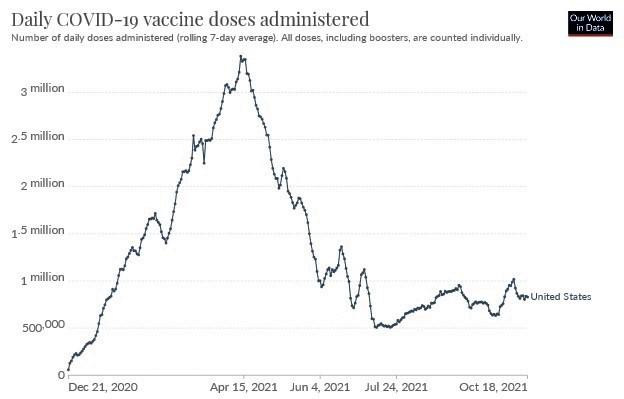As we grind on toward the two-year anniversary of this pandemic and assess where we are, the question on everyone's mind is, What's ahead? With profound regret and sadness, we acknowledge the 5 million deaths worldwide and the nearly 750,000 Americans who have perished from COVID19. That's an astonishing death toll, promising to rival that of the 1918 influenza pandemic. We are not yet done. More outbreaks will occur, and more people will die, primarily among the unvaccinated.
The Good, Bad, and Ugly
I divide our current situation into good things, bad things, things we got right, and things we got wrong. The most obvious good things were the messenger RNA vaccines from Pfizer and Moderna. While to some they seemed to arise in a hurry, in point of fact they were decades in the making, drawing on the basic research of Kati Karik, Drew Weissman, and Barney Graham. These vaccines have saved an incalculable number of lives and have given us hope for a return to a less frightening way of life. The basic mRNA technology will open up vaccines and cures for other infectious and chronic diseases far into the future. Other serendipitous good things include the virtual absence of influenza deaths during the pandemic. Usually more than a hundred children die of influenza during an influenza season. During the 2020-2021 season, only one child in the United States died of influenza. Whether influenza will come roaring back as we drop COVID mitigation strategies depends in part on our behavior and in part on the vagaries of the influenza virus itself. Get your flu shot.

Timeline Vaccination caption: Timeline of daily COVID-19 vaccine doses administered in the United States as of October 19, 2021. (Our World In Data, CC BY 4.0 <https://creativecommons.org/licenses/by/4.0>, via Wikimedia Commons)
The bad things, regrettably, are numerous: the unnecessary deaths among the unvaccinated, insufficient and inadequate personal protective equipment for healthcare workers, the polarization of our society and the politicization of vaccines and masks, the deep pandemic fatigue all are experiencing, the exhausted and discouraged healthcare workers, the overwhelmed healthcare system, and the yet-to-be- reckoned-with enormous healthcare burden of long-haul COVID, which will haunt us for many decades into the future. The saddest of all of these is the perversion of sound public health measures into oppositional political tribalism and the loss of any concern for the common good. The virus doesn't care what your political party is or what liberties you hold dear. It is only looking for a susceptible respiratory tract in which to replicate. We seem to have lost all compassion for our fellow man, woman, or child. Unvaccinated people are a risk to themselves and to others. Get fully vaccinated if you haven't done so already. If you are fully vaccinated, thank you for looking after yourself and your neighbors.
The most important things we got right were the successful mitigation strategies that slowed the virus before vaccine deployment and on which we continue to rely today. These include mask wearing, especially in indoor spaces, staying close to home, avoiding crowds, and focusing on outdoor activities. All these successes revolve around the recognition that transmission of the virus is primarily via the aerosol route, via small particles that hang in the air for long periods of time, a scientific fact that was not entirely clear as the pandemic began.
Things we got wrong included an erroneous focus on feared contamination of fomites (objects that may carry infectious agents), which produced misguided and ridiculous practices like washing groceries, erecting Plexiglas barriers, and massive efforts to sterilize and sanitize inanimate objects and environments. We focused too much on large droplets for transmission which led us to place excessive faith in the infamous six-foot rule, and too little emphasis on good ventilation in indoor spaces.
Lessons and Forecasts
So what can we conclude so far? The virus is completely nonpartisan. We have exposed wide cracks and fissures in our healthcare system, amplifying already extant disparities in healthcare access and delivery among disadvantaged groups and people of color. We have revealed the FDA and the CDC to be insufficiently nimble to meet the exigencies of a rapidly evolving pandemic. We have exposed huge weaknesses in our supply chains. We need better ventilation and air quality in our schools and office buildings. Most important, we exposed our loss of communitarian spirit and our lack of dedication to the common good. If we can't come together to combat a once-in-a-century pandemic, when will we come together in common cause?
What does the future hold? As many others have said, this virus will become endemic, part of the ongoing pathogen landscape, and will surface in intermittent outbreaks, primarily among the unvaccinated. Children down to the age of 6 months will receive COVID vaccine, which will become part of the routine childhood immunization schedule. Some of us have already received booster doses of vaccine; boosters will likely be available for most if not all adults soon. COVID vaccine will be incorporated into the annual flu shot, which we will receive annually to keep immunity from waning. In areas of outbreak, mask wearing indoors will be recommended and mask wearing, as needed, will become accepted and routine. Furthermore, we must search for lessons learned as we examine what went well and what did not go well, including how to better ventilate our indoor spaces and, as a collateral benefit, how to prevent influenza illness and death going forward.
Sooner or later, there will be another pandemic for which we must be better prepared. Above all, we must heal our national divide and return to caring about our neighbors and the common good before the next catastrophe arrives.
Margan Zajdowicz, MD, MPH, Co-chair, Healthcare Committee